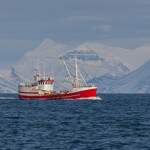Representative offices and embassies step up promotional efforts at Japanese seafood show

The 23rd Japan International Seafood and Technology Expo took place from 8 to 10 November, though Japan’s continuing quarantine requirements for entrants from many countries limited its international participation.
Foreign exhibitors were mostly limited to those that have a Japan representative office, or those whose embassy organized a national booth. The number of visitors was estimated at 15,000 – up from 9,426 in 2020, but far short of the 34,018 in pre-pandemic 2019. There were 380 exhibiting companies, as compared with 300 last year and 835 in 2019.
The Alaska Seafood Marketing Institute (ASMI) was at the show, promoting the Responsible Fisheries Management (RFM) eco-label, which it helped to create in 2010 and transferred to the Alaska-based nonprofit Certified Seafood Collaborative (CSC) in 2020. RFM was the first certification program to achieve recognition by the Global Sustainable Seafood Initiative's (GSSI) Global Benchmark Tool, which indicates alignment with the United Nations Food and Agriculture Organization (FAO) Code of Conduct for Responsible Fisheries.
According to ASMI Trade Representative Akita Yakata, the main benefits of the RFM label are that it is much cheaper than MSC as it has no logo-licensing fees, and that the label includes the origin name, so that regional branding can be promoted along with sustainability. Most of Alaska’s fisheries are actually certified by both programs, with crab being the only fishery that is RFM-certified but not MSC-certified, according to Yakata.
“But what’s happening with crab? Unfortunately, it’s closed!” Yakata said, referencing a catastrophic drop in Alaska’s snow crab population that led the state to set a much lower quota for the upcoming season, as well as a significant drop to the Bering Sea bairdi crab quota, and the closure of the winter Bristol Bay red king crab fishery. “The management is very strict, so when the numbers are low, they can’t catch. I suppose that’s a good thing, because it shows the system is working, but it’s just as we have promoted the RFM for crab.”
In Japan, another alternative to MSC labeling is the Marine Eco-Label (MEL). This was also formerly an industry-run program, but has now also been spun off to third-party management. MEL is also GSSI certified. More retailers that formerly only promoted Marine Stewardship Council (MSC) eco-labeled products are now broadening their scope to include products certified by any eco-label program that is GSSI-recognized, according to Hilton Tokyo Bay Director of Operations Akshat Sinha, who was spotted at the MEL booth along with other executives of the Hilton hotel chain, who were looking at a variety of MEL-certified products.
“We’ve recently signed a [memorandum of understanding] with MSC, but we’re also seeing a lot MEL here [at the show],” Sinha said.
Australia’s booth at the show featured Murray cod (Maccullochella peelii) and barramundi (Lates calcarifer). The Australian Embassy’s Senior Business Development Manager Kaori Shinoda said the Australian government is trying to promote barramundi consumption and has also supported its display at shows in Spain and South Korea. Shinoda described barramundi as being very suitable for grilling, as its skin becomes crispy, and though quite large, barramundi can be cut up into fillet slices like salmon.
Seafood Scotland did not introduce new items, as no Scottish producers could attend the show. The organization’s goal at this year’s event was just to maintain awareness of their current exports, including cold-smoked salmon, lobster, scallops, brown crab (Cancer pagurus), and langoustines (Nephrops norvegicus).
K-FISH, South Korea’s national brand for its fisheries exports, was active at the show, introducing two new fried rice products in 250-gram plastic packs: Abalone Seafood Fried Rice and Kimchi-Flavored Fried Rice from Jeonbuk-based Taesong Co. Abalone from South Korea’s Wando Bay is already popular in Japan.
PROM PERU, Peru's export and tourism promotion agency, also exhibited at the show. Fernando Albareda, commercial counselor at the Embassy of Peru, said Peru’s catch of Humboldt squid is being maintained at a steady level so as not to deplete the resource, while canned mackerel production has been growing. Additionally, the country is becoming a processing hub for other South American countries, since it has free trade agreements with many countries, including Canada, Chile, China, Venezuela, Costa Rica, the European Union, the European Free Trade Association, Honduras, Japan, Mexico, Panama, Singapore, South Korea, and Thailand. Red shrimp from Argentina are one of the products often processed in Peru. Albareda said that tails are exported to Japan, while the E.U. prefers whole shrimp.
The Pacific Island Center (PIC), which promotes trade, investment and tourism between the Forum Island Countries and Japan, exhibited information on seafood originating from Pacific island countries.
Photo courtesy of Chris Loew/SeafoodSource






Share